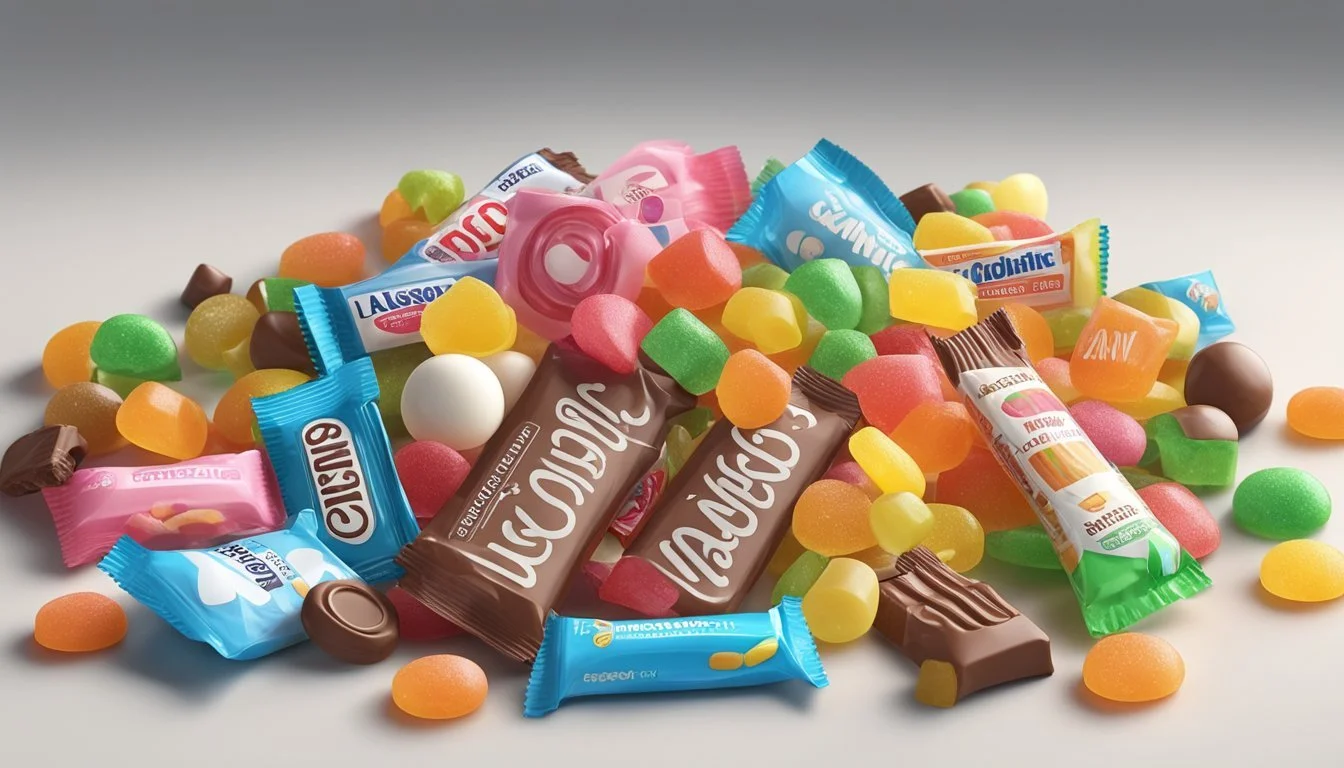What Are Some Lactose-Free Candy Options
Your Guide to Sweet Indulgence Without the Dairy
For individuals with lactose intolerance or those following a dairy-free diet, finding candy options that cater to their dietary needs can be a challenge. Traditional candies often contain milk or milk derivatives, which are unsuitable for those avoiding lactose. However, the market has evolved, offering a variety of lactose-free candies that ensure everyone can enjoy sweet treats without the worry of consuming dairy. These options not only cater to dietary restrictions but also to those seeking vegan-friendly choices.
The variety of dairy-free candies available includes confections such as coconut milk caramels, fruit-flavored gel slices, and chocolate bars made with alternative milk substitutes like oat milk. Brands like Cocomels create indulgent caramels without the use of dairy, while companies such as Enjoy Life offer mini chocolate bars with the label 'allergy-friendly' to signify their commitment to being safe for those with food sensitivities. Additionally, simpler treats like hard candies and lollipops, for instance, Dad's Root Beer Barrels and Dum Dums, typically do not contain lactose, making them a safe choice.
With increasing awareness and demand for inclusivity in dietary preferences, the confectionery industry caters to a wider audience by producing treats that are both delicious and lactose-free. This ensures that individuals with dietary restrictions can still indulge in the pleasure of candies without compromising their health or values. As always, it is important for consumers to check labels for ingredients and allergen information to ensure the sweets they choose are aligned with their dietary needs.
Understanding Lactose Intolerance
Lactose intolerance impacts digestion due to the body's inability to process a certain sugar found in dairy products. This condition can manifest in various symptoms and requires careful attention to ingredients in candies and other foods.
Symptoms of Lactose Intolerance
Individuals with lactose intolerance often experience digestive distress after consuming foods that contain lactose because their bodies produce insufficient amounts of the enzyme lactase, essential for breaking down lactose. Symptoms can include:
Gas
Diarrhea
These symptoms can range from mild to severe and typically occur within a few hours after consuming lactose-containing products.
Lactose and Candy Ingredients
When examining candy ingredients for potential lactose content, it is crucial to recognize that lactose is a sugar derived from milk products. Ingredients to look out for include:
Milk solids: Powdered milk or milk by-products that contain lactose.
Casein: A protein found in milk that can indicate the presence of lactose.
Lactate or lactic acid: While often dairy-free, they can sometimes be derived from dairy sources.
Reading labels is vital, as even small amounts of lactose can cause symptoms in sensitive individuals. Understanding the variety of terms that could signify lactose is essential for those with lactose intolerance to make informed dietary choices.
Identifying Lactose-Free Candies
For individuals with lactose intolerance or those following a dairy-free diet, it’s crucial to understand which candies are safe to enjoy. Proper examination of labels and familiarizing oneself with commonly lactose-free candies can lead to a satisfying, worry-free treat experience.
Reading Labels for Lactose Content
It is essential to review candy labels carefully for ingredients that indicate the presence of lactose. Dairy derivatives like milk, butter, and dairy fats are often included in candies for their textural and flavor contributions. One must look for ingredients like whey, casein, and milk solids which are indicators of lactose. Some labels may also have allergy-friendly labels, designating them as safe for those with dairy sensitivities. Pay special attention to labels that mention cross-contamination risks if the candy is produced in a facility that also processes dairy.
Common Lactose-Free Candy Types
Certain types of candy tend to be lactose-free more often than others:
Gum: Usually does not contain lactose, but one should still confirm by reading the label.
Lollipops: Primarily sugar-based and often free from dairy ingredients.
Hard Candies: Similarly to lollipops, many hard candies do not include dairy.
Jelly Beans: These are typically dairy-free, but it's always best to check the label as some specialty flavors may contain dairy derivatives.
Gummy Bears: Many gummy candies are made without dairy, though it's advisable to verify the ingredients to ensure they do not contain gelatin sourced from dairy.
Additionally, confectionery brands sometimes offer dairy-free versions of popular candies, such as chocolate bars made with oat milk or sunflower butter cups, which are explicitly marketed as dairy-free. It is always prudent to conduct due diligence by examining packaging and company websites for dairy-free claims and certifications.
Popular Lactose-Free Brands and Products
For those with lactose intolerance or dairy allergies, a variety of brands offer delicious lactose-free candy options that cater to both chocolate lovers and those who prefer fruity or other non-chocolate candies.
Recommended Chocolate Options
Enjoy Life Chocolate: This brand is well-known for its allergen-friendly chocolates, offering a range of products including dark chocolate bars that are dairy-free and suitable for vegans.
Raaka Chocolate: Raaka is popular for its unique unroasted, bean-to-bar chocolates, which are not only lactose-free but also soy- and gluten-free.
PASCHA Chocolate: PASCHA's products boast a purity that appeals to health-conscious consumers, focusing on organic, vegan chocolates free from dairy and other common allergens.
Lovo Chocolate: Lovo specializes in lactose-free chocolate options, including a delectable dark chocolate that provides a rich, creamy experience without the use of milk.
Non-Chocolate Candy Varieties
Skittles: These bright, fruity candies are dairy-free, making them a suitable choice for those avoiding lactose-containing products.
Sour Patch Kids: A fan favorite, Sour Patch Kids are a chewy treat without any lactose content, offering that sour-then-sweet flavor profile.
Smarties: Smarties candies are free of most common allergens, including dairy, providing a worry-free option for those with dietary restrictions.
Swedish Fish: Another classic, Swedish Fish are a gelatin-free and dairy-free candy that embody a chewy texture and a fruit-flavored sweetness.
Consumers looking for lactose-free chocolates and candies have a diverse range of products to choose from, thanks to brands that are dedicated to creating high-quality and inclusive treats that cater to multiple dietary needs.
Homemade Lactose-Free Candy Recipes
For those seeking to enjoy sweets without lactose, one can create delightful candies at home using a variety of ingredients that cater to both beginners and those with more advanced culinary skills. These homemade treats can be crafted using healthy fats, natural sugars, and, when desirable, nuts and fruits for added flavor and nutrition.
Simple Recipes for Starters
Coconut Oil Chocolate Treats: Beginners may start with a basic dairy-free chocolate recipe using coconut oil as the base. These chocolates are easy to make, only requiring a few steps:
Melt coconut oil in a microwave-safe bowl.
Whisk in cocoa powder, a pinch of salt, and vanilla extract.
Sweeten with maple syrup and, if desired, a hint of instant coffee to enhance the chocolate flavor.
Pour the melted mixture into silicone molds and refrigerate until set.
Vegan Caramels: Another simple confection is dairy-free caramel, consisting of:
Light brown sugar for sweetness
Coconut milk for creaminess
A vegan buttery spread to replicate the butter's rich texture.
One cooks these ingredients together, stirring constantly to ensure even melting and caramelization, before pouring it onto a lined tray to cool and set.
Gourmet Options for the Experienced
Experienced candy-makers can indulge in more complex recipes, often incorporating a wider range of flavors and textures, such as fruits and nuts, into their lactose-free creations.
Dairy-Free Fruit and Nut Bars: Combine finely chopped nuts like almonds or cashews with dried fruits such as cranberries or apricots. Sweeten with honey or agave nectar, and bind together with melted dairy-free chocolate. Press into a lined form, chill, and then cut into bars.
Sophisticated Maple Pecan Brittle: This upscale twist on classic peanut brittle involves:
Toasting pecans for a deep, nutty profile.
Creating a sugar syrup from brown sugar and healthy fats like coconut oil.
Incorporating a small amount of bourbon or vanilla for an aromatic depth, although this is optional.
Spreading the mixture thin on a prepared surface and letting it harden, resulting in a satisfying crunch.
Each lactose-free candy recipe not only meets dietary restrictions but also offers a joyful experience of homemade dessert making, enabling one to enjoy the process alongside the sweet results.
Allergy Considerations and Alternative Ingredients
For individuals with milk allergies or lactose intolerance, finding suitable candy requires awareness of dairy alternatives and understanding which products are safe for special occasions.
Choosing Substitutes for Dairy Ingredients
Dairy ingredients such as milk powder, casein, and sour cream are common in many candies, contributing to texture and taste. Replacing these ingredients without compromising quality demands careful selection. Dairy-free alternatives include coconut oil, almond milk, and soy-based products, which can mimic the creamy consistency and flavor of dairy products. When selecting candy, it's vital to look for labels that indicate the absence of dairy components, including lactose, whey, curds, and milk casein. Soy lecithin is a common emulsifier in chocolate that doesn't contain dairy. However, always check for an allergy-friendly label to confirm the absence of dairy.
Common Dairy Ingredients: Milk powder, butter, dairy fats, casein.
Coconut oil, sunflower oil (for texture)
Almond milk, soy milk (for creaminess)
Lecithin (as an emulsifier)
Care should be taken to avoid cross-contamination, as products processed on the same equipment as dairy may still pose a risk for those with severe milk allergies.
Allergy Safe Candy for Special Occasions
During special occasions like Halloween and Easter, allergy-safe candies become particularly important. To ensure a safe and enjoyable experience for individuals with allergies, especially during trick-or-treating, opt for candies that are clearly labeled as free from top allergens. For instance, dairy-free peanut butter cups or fruit slices can be a safe bet for those avoiding dairy. Non-food treats, such as stickers or small toys, offer an excellent alternative for children with multiple food allergies and keep the festive spirit alive.
Safe Candy Options:
Halloween: Dairy-free chocolate bars, jelly fruit slices
Easter: Marshmallows shaped like bunnies and eggs
General: Organic mints, pastilles without top allergens
Choosing treats that are made without common allergens like dairy, eggs, and peanuts can make celebrations more inclusive. Substituting traditional dairy-laden candies with these alternatives ensures everyone can partake in the fun of special occasions.
Shopping Smart for Lactose-Free Candy
Selecting lactose-free candy involves knowing where to find these options and understanding their quality and pricing. Both aspects are vital for making informed choices while accommodating dietary restrictions.
Where to Find Dairy-Free Options
Consumers can locate dairy-free candy varieties at most health food stores and supermarkets with specialized sections. Online retailers and niche candy shops are additional sources, where the range is often more extensive. Product labels are crucial; look for terms like vegan or dairy-free which often indicate the absence of lactose. Popular brands that typically offer dairy-free candy include Airheads, Atomic Fireballs, and Chick-O-Sticks.
When celebrating occasions like Halloween, some companies may offer seasonal dairy-free products, which are usually highlighted in their promotional materials. Reading online guides from trusted organizations or specialty blogs can also provide an updated list of suitable products.
Understanding Quality and Pricing
The quality of lactose-free candy can vary, with some brands using alternative ingredients to replicate the creamy texture traditionally provided by milk products. Pricing for dairy-free options also tends to vary. Factors affecting the price include the type of ingredients used and the manufacturing process, which may differ from traditional candy production.
Generic brands might offer more affordable options, but it's important to read ingredient labels to confirm they meet dietary requirements. Premium brands may use higher quality ingredients or artisanal production methods, which can be reflected in their prices. Consumers should consider the cost-per-unit or weight to compare pricing accurately across different brands and products.
Here is a simple comparison table for a quick pricing reference:
Brand Type of Candy Price Range Airheads Chewy Candy, Vegan $ Atomic Fireballs Hard Candy, Vegan $ Premium Dairy-Free Chocolates Varied $$$
It's important to remember that while some dairy-free candies may be priced higher, this can be indicative of superior quality, organic ingredients, or ethical production practices.
Additional Resources
For individuals seeking lactose-free candy options, numerous online platforms provide in-depth information and answer common questions. These resources range from specialist blogs dedicated to dairy-free lifestyles to comprehensive FAQs on food-related websites.
Blogs and Forums
Various blogs such as Simply Whisked and My Life After Dairy offer extensive guides on dairy-free candies, especially tailored to festive occasions like Halloween. These websites are often curated by individuals with personal experiences in navigating a lactose-free diet, providing a rich source of tips and recommendations.
Simply Whisked: Features a Dairy-Free Halloween Candy Guide
My Life After Dairy: Hosts a list of lactose-free candies suitable for Halloween
Additionally, forums and discussion groups can serve as a platform for sharing personal recommendations and newly discovered products.
Frequently Asked Questions (FAQs)
FAQ sections on food blogs and allergy-specific websites serve as a quick reference for commonly asked questions about lactose-free candy choices. They address concerns such as ingredient checks and understanding labels to ensure candies do not contain dairy derivatives.
What to look for: Key indicators in ingredient labels
Candy types: Types of candies that are typically dairy-free, like sour candies, hard candies, and certain chocolate brands
By exploring these FAQs, consumers can gain a clearer understanding of what options are available and how to select safe treats for their dietary needs.
Conclusion
Those seeking lactose-free candy options have a variety of choices available that cater to their dietary restrictions. Companies like Enjoy Life Foods have risen to the challenge, offering a selection of sweets that exclude common allergens, including lactose. Their range includes chocolate bars, chewy bars, and cookies, providing a safe haven for consumers who require lactose-free products.
Consumers are encouraged to carefully read labels as some candies may contain dairy-derived ingredients that could cause discomfort. Ingredients such as milk, butter, and dairy fats are common in traditional confectionery for their texture and taste. However, lactose-free alternatives often employ substitutes like oat milk and rice milk to achieve a similar sensory experience without lactose.
For those with lactose intolerance or a preference for lactose-free foods, it is reassuring to know that there are indulgences available that do not compromise on flavor or variety. The market's growing inclusivity ensures that everyone can enjoy treats that align with their dietary needs, providing peace of mind and an enjoyable taste experience.









